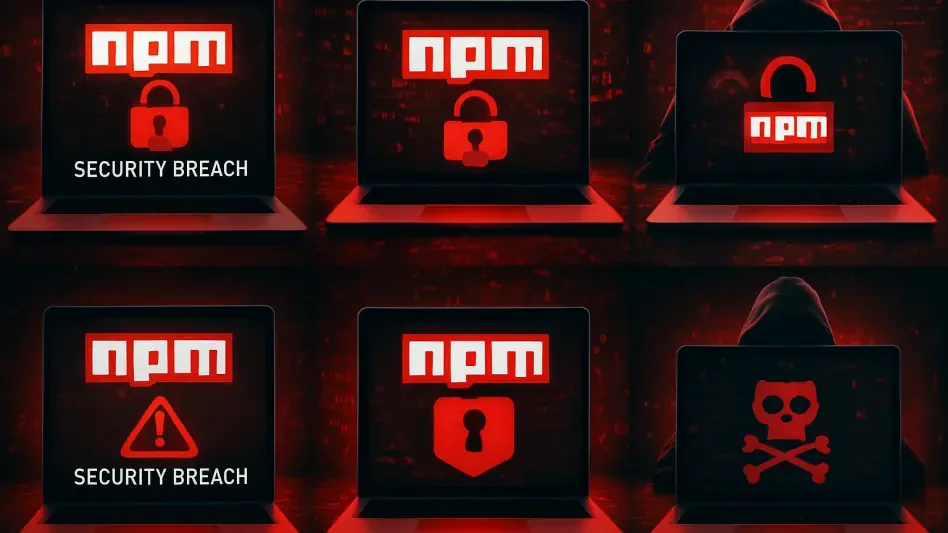Imagine a digital ecosystem where millions of developers rely on a single platform to build and share critical software components, only to discover that a cunning attack has slipped through the cracks, targeting the very foundation of their work. This scenario became reality with a recent security breach in the Node.js package manager (npm), a cornerstone of modern software development. The incident, driven by a social engineering attack, compromised several widely used open-source packages, sending ripples of concern through the tech industry. This roundup aims to gather diverse perspectives, expert opinions, and actionable tips from across the community to unpack what happened, assess the response, and chart a path forward for securing the open-source landscape.
Diving into the Npm Incident: What Experts Are Saying
The npm breach has sparked intense discussion among security professionals, developers, and industry analysts about the vulnerabilities inherent in open-source ecosystems. Reports indicate that the attack hinged on a deceptive two-factor reset email, tricking a key maintainer into relinquishing control of their account. This allowed malicious code to be uploaded to 18 high-profile packages, some of which rack up over 2 billion downloads weekly. Many experts have pointed out that this incident underscores the fragility of systems reliant on human vigilance, especially in a space often supported by volunteer efforts.
Contrasting views emerge when assessing the severity of such breaches. Some industry voices argue that the scale of potential damage—given the massive download numbers—highlights a systemic flaw in open-source security protocols. Others counter that the incident, while alarming, serves as evidence of the community’s resilience, noting how quickly the threat was identified and mitigated. This divergence in opinion sets the stage for a deeper exploration of the attack’s mechanics and the varied reactions it provoked.
A recurring theme in discussions is the need for heightened awareness around social engineering tactics. Several security analysts emphasize that phishing attempts, like the one used here, exploit trust rather than technical weaknesses, making them particularly insidious. Their consensus points toward a broader cultural shift in how maintainers and developers approach account security, urging a reevaluation of current practices across platforms like npm.
Breaking Down the Breach: Perspectives on Mechanics and Impact
Unraveling the Attack: Social Engineering in Focus
The core of this breach lies in a sophisticated phishing scheme that duped a maintainer into compromising their npm account. Industry observers describe the tactic as a calculated move, using a fake reset email to bypass two-factor authentication and gain access to upload harmful code. The affected packages, integral to countless projects, became potential vectors for cryptocurrency theft, raising immediate red flags among developers worldwide.
Differing opinions surface on the preventability of such human-error-driven attacks. Some security specialists suggest that no amount of technical safeguarding can fully eliminate the risk when human judgment is the weak link, especially in an environment where maintainers often work without formal support. Others argue that better training and standardized protocols for verifying communications could significantly reduce these risks, pushing for systemic rather than individual solutions.
The scale of the targeted packages amplifies the concern. With billions of downloads at stake, the incident has prompted a vocal faction of experts to call for mandatory security audits for high-impact projects. This viewpoint clashes with those who worry that over-regulation might stifle the open-source ethos, revealing a tension between safety and innovation that continues to shape the discourse.
Swift Detection: Community Response Under Scrutiny
One point of agreement among commentators is the remarkable speed of detection that limited the breach’s impact. Analysts note that the attacker’s use of a familiar obfuscation method made the malicious code stand out to vigilant developers, who flagged the issue within hours. Npm’s intervention, removing the tainted packages in just six hours, and the maintainer regaining control shortly after, has been widely praised as a model of rapid response.
However, opinions split on whether this success masks deeper issues. Some industry leaders caution that relying on community alertness is unsustainable, advocating for automated detection tools to shoulder more of the burden. In contrast, others celebrate the human element, arguing that the collaborative nature of open-source projects is precisely what enables such quick containment, positioning it as a strength rather than a liability.
Data from the incident adds weight to the discussion, showing that the compromised packages were live for a minimal window, drastically reducing exposure. This has led to debates on whether the tech industry overreacts to supply-chain threats, with certain experts suggesting that current systems, while imperfect, are more robust than public perception implies. This perspective challenges the narrative of inevitable catastrophe often tied to such breaches.
Assessing Damage: Mixed Views on Outcomes
Post-incident analysis reveals a surprisingly small impact, with blockchain tracking indicating only about $1,027 in stolen cryptocurrency despite initial fears of massive losses. Many in the security field view this as a stroke of luck, attributing the limited fallout to the swift response rather than any inherent safeguard. They warn that without systemic improvements, future attacks might not end so favorably.
Regional and sectoral differences in exposure have also drawn attention, with some analysts noting that certain industries relying heavily on npm were more vulnerable but largely unaffected due to the quick mitigation. Others question why the attacker’s wallet held a mere $66.52, suggesting either a botched execution or a lack of downstream targets, which fuels speculation about the true intent behind the breach.
A significant divide exists in interpreting this minimal damage. While some voices in the tech community argue that it proves the effectiveness of existing detection mechanisms, others contend that it downplays the potential for disaster, urging stakeholders not to grow complacent. This split highlights a broader conversation about balancing risk perception with practical outcomes in cybersecurity narratives.
Wider Targets: Systemic Risks in the Spotlight
Beyond the immediate incident, reports confirm that the phishing campaign targeted multiple npm maintainers, compromising additional packages in a coordinated assault on the ecosystem. Industry watchers draw parallels to past breaches, noting a pattern of attackers exploiting the open-source supply chain’s reliance on trust and accessibility. This has reignited calls for structural reforms to protect against such widespread attempts.
Expert opinions vary on the scope of the threat. Some argue that these incidents reflect a growing sophistication in attack strategies, predicting an escalation in targeting critical infrastructure over the next few years from 2025 onward. Others believe the community’s ability to adapt and respond, as demonstrated here, will keep pace with evolving dangers, provided there is adequate investment in security resources.
Speculation on future attack vectors adds another layer to the dialogue, with suggestions ranging from AI-driven phishing to insider threats. While viewpoints differ on the most pressing risks, there is broad agreement that bolstering support for maintainers—through funding, tools, or training—remains a critical step. This focus on systemic change aims to address vulnerabilities without duplicating earlier discussions on community response.
Building Defenses: Collective Tips for a Safer Ecosystem
Drawing from the incident, a variety of actionable recommendations have emerged from across the tech sphere. Many security professionals advocate for multi-layered authentication processes, emphasizing that single points of failure, like a reset email, must be eliminated. This advice is paired with calls for regular training on recognizing phishing attempts, tailored to both maintainers and end-users who interact with open-source tools.
Another frequent tip centers on funding and resource allocation. Numerous industry leaders stress the importance of financial backing for open-source projects, which often lack the budget to prioritize security. Suggestions include corporate sponsorships and government grants to develop community-driven tools that can audit dependencies and flag anomalies before they escalate into crises.
Practical strategies for individual developers also feature prominently. Experts recommend routine checks of project dependencies to ensure integrity, alongside active participation in security-focused open-source initiatives. This hands-on approach, combined with broader institutional support, forms a dual strategy that many believe can fortify the ecosystem against future threats, empowering all stakeholders to play a role.
Reflecting on the Path Forward
Looking back, the npm security breach stood as a stark reminder of the delicate balance between innovation and vulnerability in the open-source world. The varied insights from experts and analysts illuminated both the immediate effectiveness of the community’s response and the lingering gaps that needed addressing. The minimal financial impact, while reassuring, did not overshadow the potential for greater harm had the detection been delayed.
Moving forward, the tech industry was encouraged to prioritize actionable measures such as enhanced authentication protocols and increased funding for security initiatives. Exploring collaborative platforms for sharing threat intelligence could have further strengthened defenses. These steps, rooted in the lessons of this incident, offered a blueprint for resilience, ensuring that the open-source foundation remained a pillar of progress rather than a point of exploitation.








